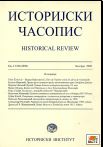Земунско становништво према попису из 1776. године
The Population of Zemun according to the 1776 Census
Author(s): Jelena Ilić MandićSubject(s): History
Published by: Istorijski institut, Beograd
Keywords: Zemun; 18th century; 1776; military communities; Habsburg Monarchy; demography; contribution
Summary/Abstract: Tumultuous political and legal circumstances, ending with the acquisition of the 1753 status of favorable autonomy as a military community, as well as excellent natural and geostrategic location, enabled Zemun an intensive demographic and economic development during the period of peace, between 1739 and 1788. According to the 1776 census, in the city of 958 households — 799 homeowners and 159 renting — there were 3918 people. Favorable circumstances stimulated young, mobile and poor population to largely settle in Zemun. Heads of households aged between 20 and 40 made up 36.86 per cent of all the heads of households, and because of their youth, families had less numerous offspring, participating with 34.1 per cent in the total male population. Overall, approximately 80 per cent of male population of Zemun was under 40. As demonstrated by the fragment about the origin of Zemun citizens based on surname, most came from some of the nearby settlements of Srem, Serbia, and Banat, mostly from the immediate vicinity of Belgrade. The great circulation of the nearby population is confirmed by the fact that the majority of population (83 per cent) were Orthodox Serbs. Some professions were in the hands of certain religious or ethnic communities. Most of the merchants were Orthodox — Serbs and Tzintzars (64), except three Jews, as well as inn owners who were mostly Orthodox (22), with the exception of two Catholics. Transporters (8) and shedders (8) were Catholic, but non-German, while there were equal numbers of Catholics and Jews among the boilermakers (2 each). All the farmers, without exception, were Serbs (84), and the most numerous artisans (194) and wage workers (267) were of mixed ethnicity.Family structure could be partially reconstructed based on the data on the size of the household (4.08 members), proportion of the young (around 42.6 per cent under 20), number of joined members (19 sons-in-law, 16 adopted ones, 31 stepsons, 7 protégés, 11 servants, and 129 learners), gender structure (47.16 percent female and 52.83 per cent males), number of widows (115), single men (34), and childless couples (130). With all this, the difference in the structure of the owners' and renters' households was also obvious in the average numbers of their members — 4.3 versus 2.3. Counting numerous joined members and renters' households (159) within the same houses, Zemun houses were insufficiently comfortable (1 to 2 rooms, a kitchen, area for cattle, one in three had cellar, and one in four had a shop).
Journal: Историјски часопис
- Issue Year: 2008
- Issue No: 57
- Page Range: 151-174
- Page Count: 24
- Language: Serbian

